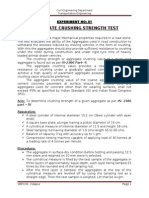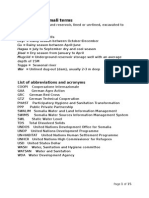Module 2-Hydrology and Irrigation Engineering
Uploaded by
Dhanendra TMGModule 2-Hydrology and Irrigation Engineering
Uploaded by
Dhanendra TMGHYDROLOGY AND IRRIGATION ENGINEERING (15CV73)
MODULE 3
3.1 RUNOFF
3.1.1 DEFINITION
3.1.2 CONCEPT OF CATCHMENT
3.1.3 FACTORS AFFECTING RUNOFF
3.1.4 RAINFALL – RUNOFF: RELATIONSHIP USING REGRESSION ANALYSIS.
3.2 HYDROGRAPHS
3.2.1 DEFINITION
3.2.2 COMPONENTS OF HYDROGRAPH
3.2.3 BASE FLOW SEPARATION
3.2.4 UNIT HYDROGRAPH: ASSUMPTION, APPLICATION AND LIMITATIONS,
3.2.5 DERIVATION FROM SIMPLE STORM HYDROGRAPHS
3.2.6 S CURVE AND ITS COMPUTATIONS
ATME COLLEGE OF ENGINEERING, MYSURU Page 1
HYDROLOGY AND IRRIGATION ENGINEERING (15CV73)
3.1 RUN OFF
3.1.1 INTRODUCTION
When precipitation occurs on land, a part of it is intercepted by vegetation and some part of it
is stored as depression storage. A part of precipitation infiltrates into the ground. The rate of
infiltration depends on the nature of the soil, moisture content in soil, topography, etc. If the
rate of precipitation is greater than the rate of infiltration, then the rainfall in excess of
infiltration will start flowing over the ground surface and is also known as over land flow.
When overland flow is occurring infiltration and evaporation may also occur. When over land
flow reaches a well-defined stream it is known as surface run off. A portion of infiltrating
water will satisfy soil-moisture deficiency. A portion may move in soil but very close to the
surface. If this also reaches a well-defined stream it is known as inter flow or subsurface
flow. Another portion of infiltration may percolate deeper into the soil to reach ground water
table. Under favorable conditions some of the ground water may reach the streams and this
portion is known as Base flow or ground water flow. A part of precipitation may occur
directly on stream surface and this is known as channel Precipitation.
Hence, Total runoff = Surface run off + Inter flow + Base flow + Channel precipitation.
It is also evident that evaporation always occurs along with transpiration.
Hence, Precipitation = Run off + Evaporation
OR
Precipitation = (Surface run off + Inter flow + Base flow + Channel precipitation) +
Evaporation
3.1.2 DEFINITIONS
1. Total Run off: This is the part of precipitation which appears in streams. It consists of
Surface run off, Inter flow, Base flow, and Channel precipitation.
2. Surface run off (SRO): This is the part of overland flow which reaches the streams.
3. Direct run off (DRO): It consists of Surface run off, Inter flow, and Channel precipitation,
but does not include Base flow. Since channel precipitation is small and inter flow is
uncertain, it is usual to include these two run offs in surface run off. Hence there is no
difference between direct run off and surface run off. Hence Total run off = Surface run off +
Base flow Since the base flow occurs in the stream after a longer time compared to surface
run off, it is necessary to separate the base flow and surface run off in preparing hydrographs.
4. Hydrograph: A hydrograph is a plot of the run off or discharge in a stream versus time.
Hydrographs may be developed for isolated or complex storms using stream gauging data.
The area under the hydrograph gives the total volume of runoff and each ordinate gives the
ATME COLLEGE OF ENGINEERING, MYSURU Page 2
HYDROLOGY AND IRRIGATION ENGINEERING (15CV73)
discharge at the instant considered. It also indicates the peak discharge and the time base of
the flood in the stream.
5. Rainfall excess: This is the portion of rainfall appearing in the stream as surface run off.
6. Effective rainfall: This is the portion of rainfall which appears in the stream as the sum of
Surface run off, Inter flow, and Channel precipitation. Since channel precipitation is small
and inter flow is uncertain, it is usual to include these two run offs in surface run off. Thus
rainfall excess and effective rainfall may be considered to be the same.
Note: Surface run off = Precipitation – (interception + depression storage + evaporation +
infiltration)
7. Channel storage: As runoff occurs in the stream, the water level will rise along the length
of the stream. Thus a large volume of water is temporarily stored in the channel. This is
known as channel storage. It reduces or moderates flood peaks. The channel storage therefore
causes delay in the appearance of discharge at any section of the stream.
3.1.3 METHODS OF ESTIMATING RUN OFF FROM BASINS
The basin area contributing to the flow in a stream goes on increasing as we go down along a
stream. Hence the section at which the flow is measured should be specified. The various
methods for estimating run off from basins are
a. Empirical formulae and charts
b. By estimating losses (evaporation, transpiration, etc.)
c. By infiltration
d. Unit Hydrograph method
e. Synthetic Unit Hydrograph method (Synder‘s method)
It is difficult to obtain even a fairly approximate estimate of run off because the various
processes such as overland flow, base flow, infiltration, evaporation, etc are highly irregular
and complex. Thus none of the above methods can be considered as accurate. However the
Unit Hydrograph method is easier and is considered as the best among the methods
mentioned.
ATME COLLEGE OF ENGINEERING, MYSURU Page 3
HYDROLOGY AND IRRIGATION ENGINEERING (15CV73)
3.2 HYDROGRAPH
A Hydrograph is a graph showing the variation of discharge versus time.
At the beginning there is only base flow (i.e., the ground water contribution to the stream)
gradually deflecting in a conical form. After the storm commences, the initial losses like
interception and infiltration are met and then the surface flow begins. They hydrograph
gradually rises and reaches its peak value after a time tp (log time or basin log) measured
from the centroid of the hydrograph of the net rain. Thereafter it declines and there is a
change of slope at the inflection point i.e., there has been inflow of the rain up to this point
and after this there is gradual withdrawal of catchment storage. There after the GDT declines
and the hydrograph again goes on depleting in the exponential form called the ground water
depletion curve or the recession curve.
3.2.1 HYDROGRAPH WITH MULTIPLE PEAKS
Basic definitions (Hydrograph features):
a) Rising limb: It is the curve or line joining the starting point ‘A’ of the raising curve and the
point of reflection. The shape of the raising line is influenced by the rainfall characteristics.
b) Peak or Crest: It represents the highest point/position of the hydrograph. Its duration also
depends on the intensity and duration of the rainfall.
c) Falling limb or depletion curve: It is the descending portion or the hydrograph. The shape
of the falling limb it mainly a function of the physical features of the channel alone and is
independent of storm characteristics (it depends on basin characters).
d) Time to peak (tp): It is the time to peak from the starting point of hydrograph
e) Lag time: The time interval from the centre of mass of rainfall to the centre of mass
hydrograph is the lag-time.
ATME COLLEGE OF ENGINEERING, MYSURU Page 4
HYDROLOGY AND IRRIGATION ENGINEERING (15CV73)
f) It is the total duration or time elapsed between the starting and ending of the hydrograph.
3.2.2 FACTORS AFFECTING THE SHAPE OF THE FLOOD HYDROGRAPH
a) Climatic factors
b) Physical factors
Climatic factors include
1) Storm characteristics, intensity, duration, magnitude and movement of storm
2) Initial loss due to interception etc.
3) Evapotranspiration
Physical factors include
1) Basic characteristics, shape, size, slope, nature of the valley, elevation, drainage density
2) Infiltration characteristics, land use and cover, soil type, geological conditions etc.
3) Channel characteristics, cross section, roughness and storage capacity
(For a given duration, the peak and volume of surface runoff are essentially proportional to
the rainfall intensity. Duration of rainfall of given intensity directly effects the volume of
runoff. If the storm moves in the downstream direction flow will be quicker at the basin.
Smaller catchments yield a more rapid and intense flood per unit area. Vegetation and forests
increase infiltration and also the storage capacity of the soils; vegetal cover reduces the peak
flow.
3.2.3 UNIT HYDROGRAPH
A unit hydrograph is defined as the hydrograph of direct runoff resulting from one cm depth
excess rainfall occurring uniformly over the basin and at a uniform rate for a specified
duration.
Assumptions:
1. The effective rainfall is uniformly distributed within the specified period of time or within
its duration
2. The time or base duration of the hydrograph of direct runoff due to an effective rainfall of
unit duration shall be constant.
3. The effective rainfall is uniformly distributed throughout the area of drainage basin.
4. The direct runoff of common base line are proportional to the total amount of direct runoff.
5. The hydrograph of runoff due to a given period of rainfall for a drainage area shows all the
combined physical characteristics.
ATME COLLEGE OF ENGINEERING, MYSURU Page 5
HYDROLOGY AND IRRIGATION ENGINEERING (15CV73)
Limitations of Unit hydrograph theory:
1. Unit hydrograph is based on the assumption that effective rainfall is uniform over the
entire basin. However it is seldom true particularly in the case of large base. As such unit
hydrograph theory is limited to the basins of size nor exceeding 6000 km2 . Thus large basins
should be subdivided & unit hydrograph should be separately developed for each basin.
2. This theory is not applicable when approachable quantity of precipitation occurs in the
form of snow.
Derivation:
1. Few unit periods of intense rainfall duration corresponding to an isolated storm uniformly
distributed over the area are collected from the past rainfall records.
2. From the collected past records of the drainage for the forms prepare the storm hydrograph
for some days after and before the rainfall of that unit duration.
3. Draw the line reporting the ground water flow and direct runoff by any of the standard base
flow separation procedures.
4. From the ordinate of the total runoff hydrograph deduct the corresponding ordinates of
base flow to obtain the ordinates of direct runoff.
5. Divide the volume of direct runoff by the area of the drainage basin to obtain the net
precipitation depth(x) over the basin.
6. Divide each of the ordinates of direct runoff by net precipitation depth to obtain the
ordinates of the unit hydrograph. i.e., ordinate of unit hydrograph (UHG) = Ordinate of direct
runoff
(FHG)/Depth of net precipitation(x) i.e, UHG=FHG/x
7. Plot the ordinates of the unit hydrograph against time since the beginning of direct runoff,
which is the unit hydrograph for the basin for the duration of the storm.
3.2.4 HYDROGRAPH SEPARATION/BASE FLOW SEPARATION:
In figure: By simply drawing a line ‘AC’ tangential to both the limbs at their lower portion.
This method is very simple but is approximate and can be used only for preliminary
estimates.
2. Extending the recession curve existing prior to the occurrence of the storm upto the point
‘D’ directly under the peak of the hydrograph and then drawing a straight line DE. Where E
is a point hydrograph ‘N’ days after the peak & N 9in days) is given by N= 0.8f
3 Where A is the area of drainage basin (km) & the size of the areas of the drainage basin as a
ATME COLLEGE OF ENGINEERING, MYSURU Page 6
HYDROLOGY AND IRRIGATION ENGINEERING (15CV73)
guide to the values of ‘N’ are given below: Area of drainage basin, km Time after peak N
(days) Simply by drawing a straight line AE, from the point of rise to the point E on the
hydrograph, ‘N’ days after the peak. By producing a point on the recession curve backwards
up to a point ‘F’ directly below the inflection point and the joining a straight line AF.
3.3 IMPORTANT QUESTIONS
Explain factors affecting Runoff?
Explain relation between rainfall & runoff using regression analysis.
With a neat sketch explain the fan and fern leaf catchment.
List out various methods for estimation of design flood. Explain rational method of flood
estimation.
Explain typical single peaked hydrograph components with a neat sketch.
Define unit hydrograph. List the assumptions made in deriving unit hydrograph and its
limitations.
Explain the procedure for drawing master depletion curve.
Explain the procedure for deriving a unit hydrograph from an isolated storm.
With a neat sketch explain S Hydrograph or summation hydrograph.
3.4 OUTCOMES
Understand the concept of hydrograph and runoff
3.5 FURTHER READING
https://nptel.ac.in/courses/105101002/9
https://nptel.ac.in/courses/105101002/7
ATME COLLEGE OF ENGINEERING, MYSURU Page 7
You might also like
- PDF Oceans Rise Empires Fall Why Geopolitics Hastens Climate Catastrophe 1. Edition Gerard Toal download100% (1)PDF Oceans Rise Empires Fall Why Geopolitics Hastens Climate Catastrophe 1. Edition Gerard Toal download73 pages
- Dams Are Still Cheaper: Types of Earthen Dam: Three TypesNo ratings yetDams Are Still Cheaper: Types of Earthen Dam: Three Types48 pages
- 1st CH - Soil Samplers - Design Features and Types - Soil EngineeringNo ratings yet1st CH - Soil Samplers - Design Features and Types - Soil Engineering13 pages
- Hydrology Eng. (3 Class) : U A C E C E .DNo ratings yetHydrology Eng. (3 Class) : U A C E C E .D32 pages
- Koe078 Soil Water Conservation EngineeringNo ratings yetKoe078 Soil Water Conservation Engineering2 pages
- Structural analysis II Quation bank for pokhara universityNo ratings yetStructural analysis II Quation bank for pokhara university33 pages
- CE-441 Foundation Engineering (2010-2016)No ratings yetCE-441 Foundation Engineering (2010-2016)26 pages
- Rain Water Harvesting System For College of Engineering, Teerthanker Mahaveer University, MoradabadNo ratings yetRain Water Harvesting System For College of Engineering, Teerthanker Mahaveer University, Moradabad9 pages
- Monitoring Report of Soil Conservation Department District Nowshera100% (1)Monitoring Report of Soil Conservation Department District Nowshera4 pages
- 1.5.2 The Seismic Coefficient Method: Earthquake Engineering Dept. of Civil Engg, UVCENo ratings yet1.5.2 The Seismic Coefficient Method: Earthquake Engineering Dept. of Civil Engg, UVCE1 page
- KENNEDY's THEORY Limitations & AssumptionsNo ratings yetKENNEDY's THEORY Limitations & Assumptions8 pages
- RK Rajput (Timber and Wood-Based Product)No ratings yetRK Rajput (Timber and Wood-Based Product)28 pages
- A Road Embankment 10 M Wide at The Formation Level 60260bc4adf4ee28005ddae8No ratings yetA Road Embankment 10 M Wide at The Formation Level 60260bc4adf4ee28005ddae83 pages
- Ce2305 Foundation Engineering 2 Marks Questions & Answers 16 Marks QuestionsNo ratings yetCe2305 Foundation Engineering 2 Marks Questions & Answers 16 Marks Questions11 pages
- Lec#1 Site Selection For Railway StationNo ratings yetLec#1 Site Selection For Railway Station123 pages
- Sanitary Engineering All PDF For B.E. 2075100% (1)Sanitary Engineering All PDF For B.E. 207581 pages
- Hydrology and Water Resources Engineering PDFNo ratings yetHydrology and Water Resources Engineering PDF2 pages
- Numerical Methods and Implementation in Geotechnical Engineering – Part 1From EverandNumerical Methods and Implementation in Geotechnical Engineering – Part 1No ratings yet
- Brochure - Field Workshop and Nature Study Camp 2023No ratings yetBrochure - Field Workshop and Nature Study Camp 20235 pages
- Organism and Population Class 12 Notes Biology Chapter 13 (PDF)100% (1)Organism and Population Class 12 Notes Biology Chapter 13 (PDF)10 pages
- Slope Movement Types and Processes - 2nd WeekNo ratings yetSlope Movement Types and Processes - 2nd Week38 pages
- CHAPTER 5 - Water Conveynance and ControlNo ratings yetCHAPTER 5 - Water Conveynance and Control43 pages
- Multiple Choice Questions (MCQS) Class: Viii: Subject: GeographyNo ratings yetMultiple Choice Questions (MCQS) Class: Viii: Subject: Geography5 pages
- Coal Resources and Their Status in Nepal, BASKOTA, Shiv Kumar, NepalNo ratings yetCoal Resources and Their Status in Nepal, BASKOTA, Shiv Kumar, Nepal19 pages
- Advancing Australian Riprap Sizing Approaches Krey PriceNo ratings yetAdvancing Australian Riprap Sizing Approaches Krey Price17 pages
- Unearthed - Environmental History of Independent IndiaNo ratings yetUnearthed - Environmental History of Independent India234 pages
- The Adam and Eve Story The History of Cataclysms and Aftermath100% (8)The Adam and Eve Story The History of Cataclysms and Aftermath243 pages
- Coal Facies Interpretations Based On Lithotype and Maceral Variations in Lowe Cretacic (Gates Formation) Coals of Western CanadaNo ratings yetCoal Facies Interpretations Based On Lithotype and Maceral Variations in Lowe Cretacic (Gates Formation) Coals of Western Canada38 pages
- Comparison BTWN Climate of Ahmedabad and NagpurNo ratings yetComparison BTWN Climate of Ahmedabad and Nagpur1 page
- Carriage Director@ Computerwing Covering Lelter: Different Directorates of RdsoNo ratings yetCarriage Director@ Computerwing Covering Lelter: Different Directorates of Rdso32 pages
- ZE Virtual Ballooning Student Activity Sheet (6)No ratings yetZE Virtual Ballooning Student Activity Sheet (6)2 pages
- PDF Oceans Rise Empires Fall Why Geopolitics Hastens Climate Catastrophe 1. Edition Gerard Toal downloadPDF Oceans Rise Empires Fall Why Geopolitics Hastens Climate Catastrophe 1. Edition Gerard Toal download
- Dams Are Still Cheaper: Types of Earthen Dam: Three TypesDams Are Still Cheaper: Types of Earthen Dam: Three Types
- 1st CH - Soil Samplers - Design Features and Types - Soil Engineering1st CH - Soil Samplers - Design Features and Types - Soil Engineering
- Structural analysis II Quation bank for pokhara universityStructural analysis II Quation bank for pokhara university
- Rain Water Harvesting System For College of Engineering, Teerthanker Mahaveer University, MoradabadRain Water Harvesting System For College of Engineering, Teerthanker Mahaveer University, Moradabad
- Monitoring Report of Soil Conservation Department District NowsheraMonitoring Report of Soil Conservation Department District Nowshera
- 1.5.2 The Seismic Coefficient Method: Earthquake Engineering Dept. of Civil Engg, UVCE1.5.2 The Seismic Coefficient Method: Earthquake Engineering Dept. of Civil Engg, UVCE
- A Road Embankment 10 M Wide at The Formation Level 60260bc4adf4ee28005ddae8A Road Embankment 10 M Wide at The Formation Level 60260bc4adf4ee28005ddae8
- Ce2305 Foundation Engineering 2 Marks Questions & Answers 16 Marks QuestionsCe2305 Foundation Engineering 2 Marks Questions & Answers 16 Marks Questions
- Numerical Methods and Implementation in Geotechnical Engineering – Part 1From EverandNumerical Methods and Implementation in Geotechnical Engineering – Part 1
- Brochure - Field Workshop and Nature Study Camp 2023Brochure - Field Workshop and Nature Study Camp 2023
- Organism and Population Class 12 Notes Biology Chapter 13 (PDF)Organism and Population Class 12 Notes Biology Chapter 13 (PDF)
- Multiple Choice Questions (MCQS) Class: Viii: Subject: GeographyMultiple Choice Questions (MCQS) Class: Viii: Subject: Geography
- Coal Resources and Their Status in Nepal, BASKOTA, Shiv Kumar, NepalCoal Resources and Their Status in Nepal, BASKOTA, Shiv Kumar, Nepal
- Advancing Australian Riprap Sizing Approaches Krey PriceAdvancing Australian Riprap Sizing Approaches Krey Price
- Unearthed - Environmental History of Independent IndiaUnearthed - Environmental History of Independent India
- The Adam and Eve Story The History of Cataclysms and AftermathThe Adam and Eve Story The History of Cataclysms and Aftermath
- Coal Facies Interpretations Based On Lithotype and Maceral Variations in Lowe Cretacic (Gates Formation) Coals of Western CanadaCoal Facies Interpretations Based On Lithotype and Maceral Variations in Lowe Cretacic (Gates Formation) Coals of Western Canada
- Carriage Director@ Computerwing Covering Lelter: Different Directorates of RdsoCarriage Director@ Computerwing Covering Lelter: Different Directorates of Rdso

























































































